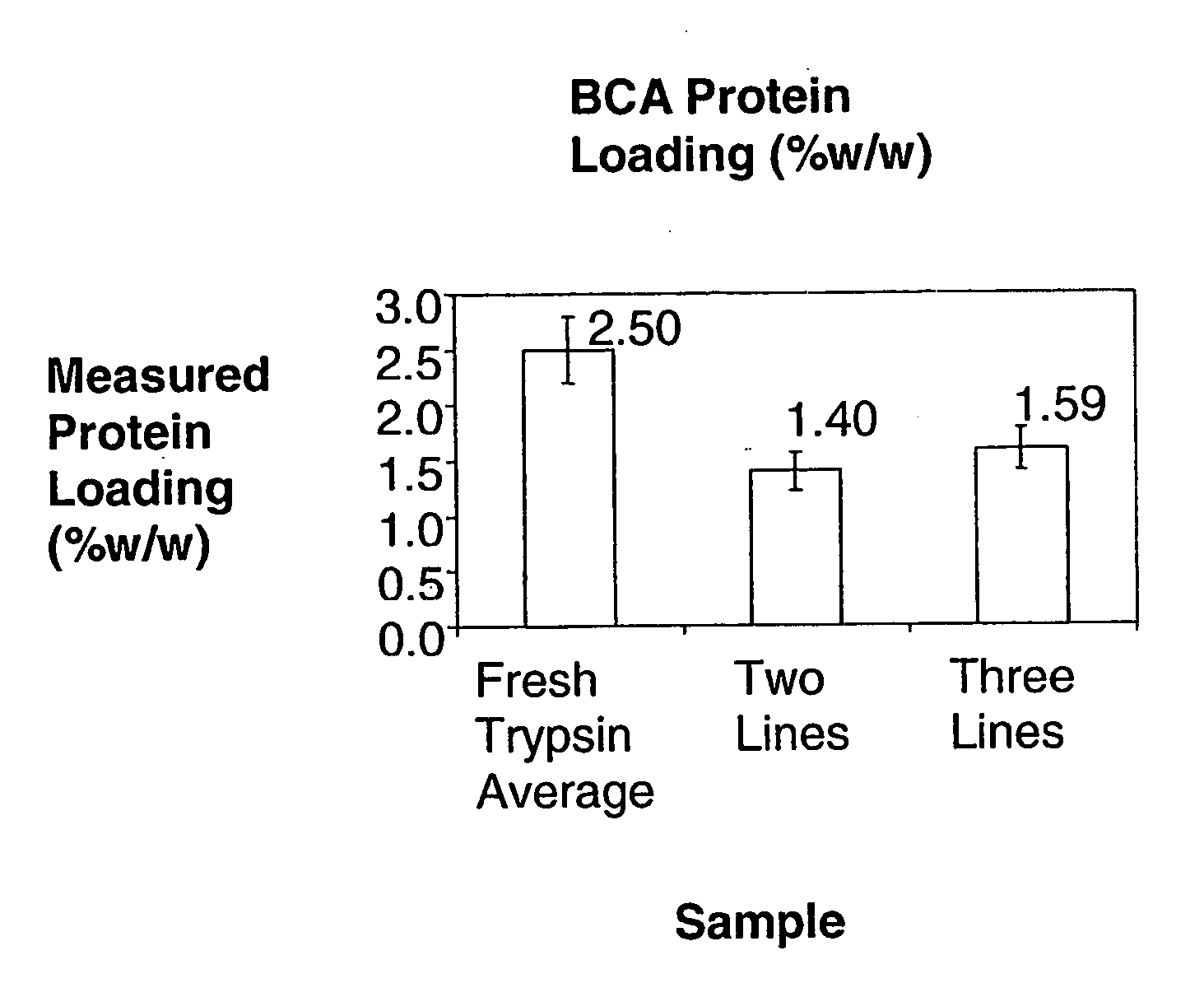Process for Preparing Microcrystals
- Summary
- Abstract
- Description
- Claims
- Application Information
AI Technical Summary
Benefits of technology
Problems solved by technology
Method used
Image
Examples
example 2
[0217]In this example, three lines were used to co-precipitate trypsin / DL-valine PCMCs using coprecipitant solutions held at different temperatures. The theoretical protein loading was 2.5% w / w; the water content was 4.0% v / v; the total flow rate was 100 ml / min. In one experiment [JV790] the aqueous DL-valine solution was heated and the concentration was 90 mg / ml and in another [JV675] the DL-valine solution was held at room temperature and the concentration was 68.571 mg / ml. Calcium chloride was not included in these experiments. In order to dissolve 90 mg / ml DL-valine in deionised water, it is necessary to heat and maintain the solution temperature at ˜90° C. Solutions were heated using a Techne Dri-Block DB-3 Heating block. This unit is thermostatically controlled, and maintains constant temperature.
[0218]The theoretical protein loading was 2.5% w / w and the excipient concentration was 90 mg / ml. In a comparative experiment where all lines were held at room temperature the theoreti...
example 3
[0227]Comparison of a 2 line or 3 Line CFCP system for coprecipitation of Trypsin / K2S04 into isopropanol, [Expt JV818].
[0228]This example was designed to determine if the previously described advantages of using a 3 line mixing process could also be obtained with coprecipitants known to coprecipitate very rapidly.
[0229]K2SO4 is an inorganic salt, which rapidly precipitates from a concentrated aqueous solution upon addition to a suitable anti-solvent such as propan-2-ol. In the literature it is well known that inorganic salts precipitate rapidly, and in many cases precipitation is so quick, that even measuring the process is difficult. Previously we have demonstrated that bioactive molecule coated microcrystals may be made with potassium sulfate using either a batch system or a two line continuous process. Further it has been consistently found (with K2SO4 and many other materials) that the coprecipitation process leads to the formation of crystals smaller than those obtained on prec...
example 4
Preparation of Antibody Coated Microcrystals by a 2 Line and 3 Line Process
[0244]Bovine IgG-coated valine microcrystals were prepared by a 2 line and 3 line process using the equipment described in Example 1 and conditions described in Table 7. The supplier of Bovine IgG (Lot 052742366) at 10 mg / ml in 0.01M sodium phosphate, 0.15M NaCl (PBS), pH 7.4 (Preservative 0.1% NaAzide) was Lampire Biologicals, PO Box 270, Pipersville, Pa. 18947. For both the 2 line and 3 line experiment the conditions are designed to produce the same theoretical protein loading in the formulation of 7.5 wt %, a final water content in the suspension of 4% v / v and the same supersaturation of valine during precipitation. The key difference between the two experiments is that in the 3 line experiment the protein is introduced into the coprecipitation in PBS buffer at pH 7.4 while in the two line experiment it is mixed with the valine coprecipitant and at a pH of around 6.2.
TABLE 7NumberPump APump BPump CofSolute...
PUM
| Property | Measurement | Unit |
|---|---|---|
| Length | aaaaa | aaaaa |
| Thickness | aaaaa | aaaaa |
| Thickness | aaaaa | aaaaa |
Abstract
Description
Claims
Application Information
 Login to View More
Login to View More - R&D
- Intellectual Property
- Life Sciences
- Materials
- Tech Scout
- Unparalleled Data Quality
- Higher Quality Content
- 60% Fewer Hallucinations
Browse by: Latest US Patents, China's latest patents, Technical Efficacy Thesaurus, Application Domain, Technology Topic, Popular Technical Reports.
© 2025 PatSnap. All rights reserved.Legal|Privacy policy|Modern Slavery Act Transparency Statement|Sitemap|About US| Contact US: help@patsnap.com



